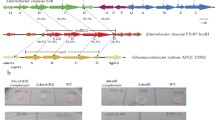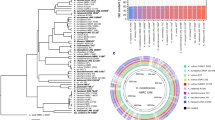Abstract
In this study, a comprehensive genome-scale metabolic network of Komagataeibacter xylinus as the model microorganism was reconstructed based on genome annotation, for better understanding of metabolic growth and biosynthesis of bacterial cellulose (BC). The reconstructed network included 640 genes, 783 metabolic reactions and 865 metabolites. The model was completely successful to predict the lack of growth under anaerobic conditions. Model validation by the data for the growth of acetic acid bacteria with ethanol-limited chemostat cultures showed that there is a good agreement for the O2 and CO2 fluxes with actual growth conditions. Then the model was used to forecast the simultaneous production of BC and by-products. The obtained data showed that the rate of BC production is consistent with experimental data with an accuracy of 93.7%. Finally, the study of flux balance analysis (FBA) data showed that the pentose phosphate pathway and the TCA cycle play an important role in growth-promoting metabolism in K. xylinus and have a close relationship with BC biosynthesis. By integrating this model with various metabolic engineering and systems biology tools in the future, it is possible to overcome the common challenges in the large-scale BC production, such as low yield and productivity.
Similar content being viewed by others
References
Yamada Y, Yukphan P, Lan Vu HT et al (2012) Description of Komagataeibacter gen. nov., with proposals of new combinations (Acetobacteraceae). J Gen Appl Microbiol 58:397–404
Czaja WK, Young DJ, Kawecki M, Brown RM (2007) The future prospects of microbial cellulose in biomedical applications. Biomacromol 8:1–12
Tonouchi N (2016) Cellulose and other capsular polysaccharides of acetic acid bacteria. Acetic acid bacteria: ecology and physiology. Springer, Tokyo
Campano C, Balea A, Blanco A, Negro C (2015) Enhancement of the fermentation process and properties of bacterial cellulose: a review. Cellulose 23:57–91
Lustri WR, Barud HG et al (2015) Microbial cellulose biosynthesis mechanisms and medical applications cellulose fundamental aspects and current trends, Matheus Poletto and Heitor Luiz Ornaghi Junior. IntechOpen. https://doi.org/10.5772/61797
Koutinas AA, Vlysidis A, Pleissner D et al (2014) Valorization of industrial waste and by-product streams via fermentation for the production of chemicals and biopolymers. Chem Soc Rev 43(8):2587–2627
Lin S-P, Calvar IL, Catchmark JM et al (2013) Biosynthesis, production and applications of bacterial cellulose. Cellulose 20:2191–2219
Reiniati I, Hrymak AN, Margaritis A (2016) Recent developments in the production and applications of bacterial cellulose fibers and nanocrystals. Crit Rev Biotechnol 37:510–524
Chawla PR, Bajaj IB, Survase SA, Singhal RS (2009) Microbial cellulose: fermentative production and applications. Food Technol Biotechnol 47:107–124
Römling U, Galperin MY (2015) Bacterial cellulose biosynthesis: diversity of operons, subunits, products, and functions. Trends Microbiol 23:545–557
Ross P, Mayer R, Benziman M (1991) Cellulose biosynthesis and function in bacteria. Microbiol Rev 55:35–58
Klemm D, Schumann D, Udhardt U, Marsch S (2001) Bacterial synthesized cellulose artificial blood vessels for microsurgery. Prog Polym Sci 26:1561–1603
Saxena IM, Kudlicka K, Okuda K, Brown RM (1994) Characterization of genes in the cellulose-synthesizing operon (acs operon) of Acetobacter xylinum: implications for cellulose crystallization. J Bacteriol 176:5735–5752
Römling U (2002) Molecular biology of cellulose production in bacteria. Res Microbiol 153(4):205–212
Valla S, Ertesvåg H, Tonouchi N, Fjærvik E (2009) Bacterial cellulose production: biosynthesis and applications. In: Microbial production of biopolymers and polymer precursors: application and prespectives, Chapter 3. Canister Academic Press, pp 43–77
Morgan JLW, Strumillo J, Zimmer J (2013) Crystallographic snapshot of cellulose synthesis and membrane translocation. Nature. https://doi.org/10.1038/nature11744
McNamara JT, Morgan JLW, Zimmer J (2015) A molecular description of cellulose biosynthesis. Annu Rev Biochem 84:895–921
Ruka DR, Simon GP, Dean KM (2012) Altering the growth conditions of Gluconacetobacter xylinus to maximize the yield of bacterial cellulose. Carbohydr Polym 89:613–622
Czaja W, Romanovicz D, Malcolm Brown R (2004) Structural investigations of microbial cellulose produced in stationary and agitated culture. Cellulose 11:403–411
Liu M, Zhong C, Wu X-Y et al (2015) Metabolomic profiling coupled with metabolic network reveals differences in Gluconacetobacter xylinus from static and agitated cultures. Biochem Eng J 101:85–98
Imai T, Sun S, Horikawa Y et al (2014) Functional reconstitution of cellulose synthase in Escherichia coli. Biomacromol 15:4206–4213
Sajadi E, Fatemi SS, Babaipour V et al (2019) Increased cellulose production by heterologous expression of bcsA and B genes from Gluconacetobacter xylinus in E. coli Nissle 1917. Bioproc Biosyst Eng 42(12):2023–2034
Buldum G, Bismarck A, Mantalaris A (2018) Recombinant biosynthesis of bacterial cellulose in genetically modified Escherichia coli. Bioproc Biosyst Eng 41:265–279
Florea M, Hagemann H, Santosa G et al (2016) Engineering control of bacterial cellulose production using a genetic toolkit and a new cellulose-producing strain. Proc Natl Acad Sci. https://doi.org/10.1073/pnas.1522985113
Sajadi E, Babaipour V, Deldar AA et al (2017) Enhancement of crystallinity of cellulose produced by Escherichia coli through heterologous expression of bcsD gene from Gluconacetobacter xylinus. Biotechnol Lett 39(9):1395–1401
Zhong C, Li F, Liu M et al (2014) Revealing differences in metabolic flux distributions between a mutant strain and its parent strain Gluconacetobacter xylinus CGMCC 2955. PLoS ONE 9:e98772
Kumar A, Suthers PF, Maranas CD (2012) MetRxn: a knowledgebase of metabolites and reactions spanning metabolic models and databases. BMC Bioinform 13:1
Kubiak K, Kurzawa M, Jędrzejczak-Krzepkowska M et al (2014) Complete genome sequence of Gluconacetobacter xylinus E25 strain—valuable and effective producer of bacterial nanocellulose. J Biotechnol 176:18–19
Ogino H, Azuma Y, Hosoyama A et al (2011) Complete genome sequence of NBRC 3288, a unique cellulose-nonproducing strain of Gluconacetobacter xylinus isolated from vinegar. J Bacteriol 193:6997–6998
Velasco-Bedrán H, López-Isunza F (2007) The unified metabolism of Gluconacetobacter entanii in continuous and batch processes. Process Biochem 42:1180–1190
Zhong C, Zhang G-C, Liu M et al (2013) Metabolic flux analysis of Gluconacetobacter xylinus for bacterial cellulose production. Appl Microbiol Biotechnol 97:6189–6199
Thiele I, Palsson B (2010) A protocol for generating a high-quality genome-scale metabolic reconstruction. Nat Protoc. https://doi.org/10.1038/nprot.2009.203
Kanehisa M, Sato Y, Kawashima M et al (2015) KEGG as a reference resource for gene and protein annotation. Nucleic Acids Res 44:457–462
Caspi R, Billington R, Ferrer L et al (2016) The MetaCyc database of metabolic pathways and enzymes and the BioCyc collection of pathway/genome databases. Nucleic Acids Res 44:D471–D480
Barthelmes J, Ebeling C, Chang A et al (2007) BRENDA, AMENDA and FRENDA: the enzyme information system in 2007. Nucleic Acids Res 35:D511–D514
Consortium U (2008) The universal protein resource (UniProt). Nucleic Acids Res 36:D190–D195
King ZA, Lu J, Dräger A et al (2016) BiGG models: a platform for integrating, standardizing and sharing genome-scale models. Nucleic Acids Res 44:D515–D522
Degtyarenko K, De Matos P, Ennis M et al (2007) ChEBI: a database and ontology for chemical entities of biological interest. Nucleic Acids Res 36:D344–D350
Attwood MM, Van Dijken JP, Pronk JT (1991) Glucose metabolism and gluconic acid production by Acetobacter diazotrophicus. J Ferment Bioeng 72:101–105
Keating SM, Bornstein BJ, Finney A, Hucka M (2006) SBMLToolbox: An SBML toolbox for MATLAB users. Bioinformatics. https://doi.org/10.1093/bioinformatics/btl111
Schellenberger J, Que R, Fleming RMT et al (2011) Quantitative prediction of cellular metabolism with constraint-based models: the COBRA toolbox v20. Nat Protoc. https://doi.org/10.1038/nprot.2011.308
Benziman M, Russo A, Hochman S, Weinhouse H (1978) Purification and regulatory properties of the oxaloacetate decarboxylase of Acetobacter xylinum. J Bacteriol 134:1–9
Benziman M, Eizen N (1971) Pyruvate-phosphate dikinase and the control of gluconeogenesis in Acetobacter xylinum. J Biol Chem 246:57–61
Li Y, Tian C, Tian H et al (2012) Improvement of bacterial cellulose production by manipulating the metabolic pathways in which ethanol and sodium citrate involved. Appl Microbiol Biotechnol. https://doi.org/10.1007/s00253-012-4242-6
Matsushita K, Matsutani M (2016) Distribution, evolution, and physiology of oxidative fermentation. Acetic acid bacteria. Springer, Tokyo, pp 159–178
Matsushita K, Toyama H, Adachi O (2004) Respiratory chains in acetic acid bacteria: membranebound periplasmic sugar and alcohol respirations. Respiration in Archaea and bacteria. Springer, Berlin, pp 81–99
Benziman M, Goldhamer H (1968) The role of ubiquinone in the respiratory chain of Acetobacter xylinum. Biochem J 108:311–316
Chávez-Pacheco JL, Martínez-Yee S, Contreras ML et al (2005) Partial bioenergetic characterization of Gluconacetobacter xylinum cells released from cellulose pellicles by a novel methodology. J Appl Microbiol 99:1130–1140
Matsutani M, Fukushima K, Kayama C et al (2014) Replacement of a terminal cytochrome c oxidase by ubiquinol oxidase during the evolution of acetic acid bacteria. Biochim Biophys Acta 1837:1810–1820
Yamada Y, Nunoda M, Ishikawa T, Tahara Y (1981) The cellular fatty acid composition in acetic acid bacteria. J Gen Appl Microbiol 27:405–417
Trček J, Jernejc K, Matsushita K (2007) The highly tolerant acetic acid bacterium Gluconacetobacter europaeus adapts to the presence of acetic acid by changes in lipid composition, morphological properties and PQQ-dependent ADH expression. Extremophiles 11:627–635
Orth JD, Conrad TM, Na J et al (2011) A comprehensive genome-scale reconstruction of Escherichia coli metabolism 2011. Mol Syst Biol 7:535
Wu X, Wang X, Lu W (2014) Genome-scale reconstruction of a metabolic network for Gluconobacter oxydans 621H. Biosystems 117:10–14
Zhang H, Ye C, Xu N et al (2017) Reconstruction of a genome-scale metabolic network of Komagataeibacter nataicola RZS01 for cellulose production. Sci Rep. https://doi.org/10.1038/s41598-017-06918-1
Liu M, Liu L, Jia S et al (2018) Complete genome analysis of Gluconacetobacter xylinus CGMCC 2955 for elucidating bacterial cellulose biosynthesis and metabolic regulation. Sci Rep. https://doi.org/10.1038/s41598-018-24559-w
Ji K, Wang W, Zeng B et al (2016) Bacterial cellulose synthesis mechanism of facultative anaerobe Enterobacter sp. FY-07. Sci Rep. https://doi.org/10.1038/srep21863
Luttik M, Van Spanning R, Schipper D et al (1997) The low biomass yields of the acetic acid bacterium Acetobacter pasteurianus are due to a low stoichiometry of respiration-coupled proton translocation. Appl Environ Microbiol 63:3345–3351
Kuo CH, Teng HY, Lee CK (2015) Knock-out of glucose dehydrogenase gene in Gluconacetobacter xylinus for bacterial cellulose production enhancement. Biotechnol Bioprocess Eng 20(1):18–25
Acknowledgements
The authors wish to thank Tarbiat Modares University for the financial support of this study.
Author information
Authors and Affiliations
Corresponding author
Ethics declarations
Conflict of interest
The authors have no conflict of interest to publish the manuscript in “Bioprocess and Biosystem Engineering”.
Additional information
Publisher's Note
Springer Nature remains neutral with regard to jurisdictional claims in published maps and institutional affiliations.
Electronic supplementary material
Below is the link to the electronic supplementary material.
Rights and permissions
About this article
Cite this article
Rezazadeh, M., Babaeipour, V. & Motamedian, E. Reconstruction, verification and in-silico analysis of a genome-scale metabolic model of bacterial cellulose producing Komagataeibacter xylinus. Bioprocess Biosyst Eng 43, 1017–1026 (2020). https://doi.org/10.1007/s00449-020-02299-4
Received:
Accepted:
Published:
Issue Date:
DOI: https://doi.org/10.1007/s00449-020-02299-4







